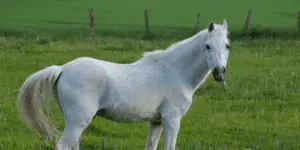
Grazing Your Horse Safely
Turn your horse out correctly! Spring is finally here and that means the paddock season

Basics That Every Horse Person Should Know
Often, the pastures which our horses graze on today, can no longer be compared to those from 200 years ago. Today’s high-performance dairy cow farming has resulted in the cultivation of grasses rich in energy, protein and sugar. Wild horses were used to grazing on large stretches of land with wild grasses, weeds and shrubs. Therefore, the grass supply is usually too lush for our domestic horses. These sown grass varieties usually contain a lot of fructan, which can be problematic for horses.
Fructan is a long-chain carbohydrate that serves as energy storage for the excess energy of a plant. It is produced during photosynthesis. This happens, for example, when it is sunny but temperatures are low and the energy gained is not used immediately for growth but gets stored instead.
Fructans are mainly metabolised by bacteria in the large intestine and are rapidly fermentable. A large intake can lead to a shift in the intestinal flora. The proportion of carbohydrate-splitting bacteria increases to the detriment of the raw fibre-splitting bacteria. When these die off, they release endotoxins, which enter the bloodstream via the damaged intestinal wall.
In the hoof corium, the toxins lead to small blood clots and thus worsen the blood circulation. These reactions of the body can contribute to the development of painful laminitis. For a long time it was thought that protein was the trigger for feed-induced laminitis, but this assumption is now outdated. Of course, the development of laminitis is related to other factors such as pre-existing diseases, poor hoof condition or a feed generally too rich in carbohydrates. In addition, it is discussed to what extent mould toxins (endophytes) living in symbiosis with grasses have an influence.
If the grass cannot grow, it stores more fructan, this happens when it is too cold or too dry. In Spring, at the beginning of the grazing season, and in Autumn, at the end of the grazing season, the highest levels of fructan are measured, as the grass is not able to grow well at this time. In August and September, on the other hand, the content is usually at its lowest. In her dissertation in 2002, Sandra Dahlhoff found that the fructan content is strongly dependent on the average temperature of the past 48 hours. When the temperatures increases, the fructan content decreases. In addition, the fructan content in the grass is mainly related to the average temperature at night. If it was colder than 8°C, the risk was generally higher. If the previous night was warmer, the risk got lower, unless it was dry for a long time. In short, whenever the grass grows, the fructan content decreases.
The following situation is particularly problematic: a lot of sun and frost. Photosynthesis can take place, but the energy produced is not converted into growth.
Contrary to popular belief among horse owners, short, mown grass is particularly high in fructan because it is stressed, can hardly grow and therefore accumulates fructan. However, regularly mowed grass that’s left at a hight around 15cm can help to reduce the sugar content in the grass.


Turn your horse out correctly! Spring is finally here and that means the paddock season

Expert Advice: Kim Lina Pethahn, an independent feed consultant, wrote this article. The Nutritional Benefits

Transitioning Horses to pasture grass: A stress-free grazing season with the Happie Horse app It’s

We have summarised everything you need to know about spring turn out to keep your

Fructan alert: How to master the grazing season month by month with the Happie Horse

Fructans and Laminitis: A Dangerous Duo Hufrehe ist eine schmerzhafte Erkrankung, die Pferde stark beeinträchtigen